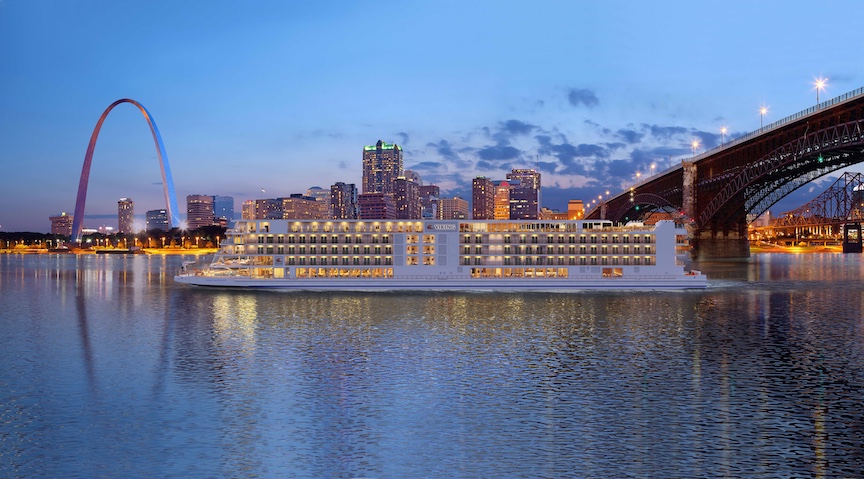
Viking entered the river cruise market with four ships in 1997 and has since expanded to 79 in the United States. This Viking ship is shown in St. Louis on the Mississippi River. Photo courtesy of Viking Cruises
By Mary Bergin
The Icon of the Seas, one of the latest behemoths in the cruise industry, launched this winter in Miami with a capacity of 5,610 guests. With its eight distinctive “neighborhoods” on board, it is a floating city vacation. Many people are attracted to these mega ships. Indeed, cruises are among the fasted-growing segments of tourism
We humans are attracted to water for all kinds of reasons, which marine biologist Wallace Nichols dives into with his bestselling book, Blue Mind. Water calms and connects us. This could be one reason for the steady allure of cruises on waterways vast and narrow, to ports popular and obscure. Regardless of destination or vessel, passengers like watching the world float by and unpacking just once – instead of lugging a suitcase from city to city and getting stressed about directions, driving, timetables, or connections.
The Icon of the Seas will attract its customers. But sometimes small is beautiful. Sophisticated travelers often prefer a small ship cruising down a historic river.
Water as a Magnet
The river cruise market is expected to grow by $3,206 million between 2022 and 2027, surpassing all travel sectors. Forbes reports that industry leader Viking began with four river ships in 1997 and expanded to 79 in 2022 (Mississippi River cruises were added that year). On-river excursions cover eight to 23 days.
In the U.S., the number of river cruises is expected to grow quickly – a compound annual growth rate of 20.8 percent from 2023 to 2030. The Mississippi River region accounted for 68 percent of that market in 2022; expect a spurt of new cruises along the Columbia and Snake Rivers in the Pacific Northwest.
CruiseCompete, which monitors cruise travel trends globally, says the most popular region for river cruising is Europe. The most popular river cruise port is Budapest and the most popular country to visit while river cruising is Germany. All major European river cruise lines sail the Rhine and Danube. Pacing and port stops tend to be the same, walking tours are usually included. You never know what you will discover.
Our Rhine excursion took us to four countries: Switzerland, Germany, France and the Netherlands. Along the Danube, we were ashore in Germany, Austria, Slovakia and Hungary.
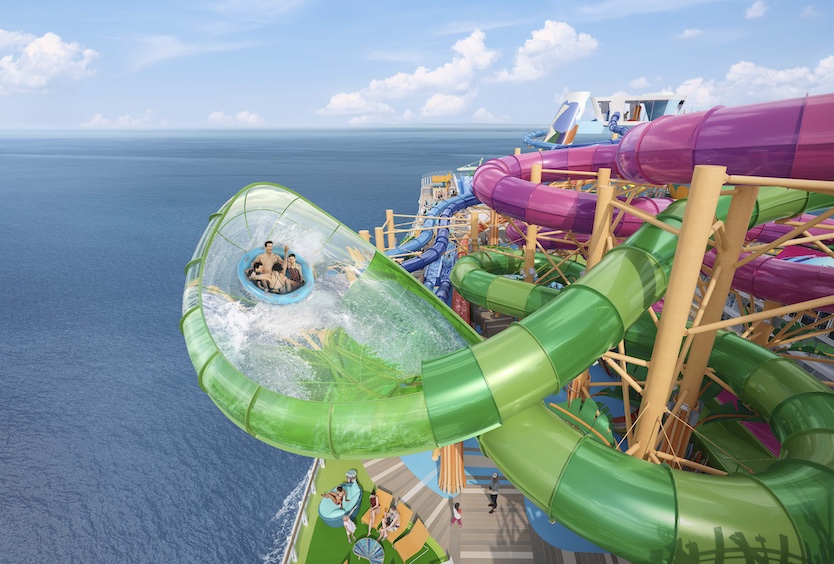
On Icon of the Seas, adventurers are in for the ultimate thrill at the largest waterpark at sea, Category 6, in the ships’ new Thrill Island neighborhood. The six record-breaking slides reach new heights, like Storm Surge, the first family raft slides with four riders per raft. Photo courtesy of Royal Caribbean
Waterfront Treasurers
Were it not for a seven-night Rhine River summer cruise between Basel and Amsterdam, I would likely not have visited the state of Hessen’s tiny town of Rüdesheim. On the Drosselgasse, a small but lively cobblestone alley, wine, beer, ice cream and oompah music and restaurants are abundant. The area produces fine Riesling wines, but the local specialty is Rüdesheimer Kaffee.
First the trademark cup and saucer: a rose-colored pattern on curvy white porcelain, designed after a German TV chef concocted the drink in 1957. Next, add sugar cubes and Asbach Uralt, a local brandy dating back to 1892. Use a long spoon to dissolve and mix. A long match sets the liquid aflame, briefly. Steaming coffee squelches the flames. Last step: garnish with sweetened whipped cream and shaved chocolate. Sip and savor.
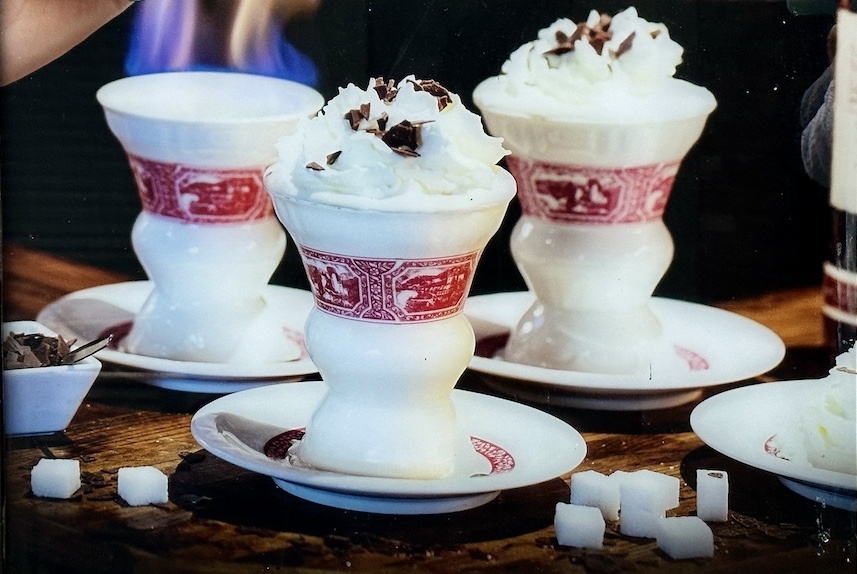
Rüdesheimer Kaffee is prepared and served with plenty of whipped cream and shaved chocolate. Roaming the cobblestone Drosselgasse to find the unusual beverage is a popular part of a Rhine River cruise.
Rüdesheim is not simply a charming town with quirky coffee. It sits within a 40-mile stretch of Middle Rhine Valley that is a UNESCO World Heritage Site because of its natural beauty and preserved architecture, remarkable trade route history and longstanding artistic influence.
Were it not for a seven-night autumn Danube River cruise from Nuremberg to Budapest, I would not have encountered the massive and remote Melk Abbey, aptly described online as the size of a small village.
Picture 1,365 windows, 497 rooms and roofs spanning about 5.5 acres. The hallowed campus hovers on top of a lofty outcropping in Austria. The gorgeous and imposing abbey, where Benedictine monks have lived since 1089, is in the scenic Wachau Valley, another UNESCO World Heritage Site.
River cruising is calming unless water levels don’t cooperate. That Danube River cruise ended with a three-hour bus ride to a Budapest hotel: Our riverboat couldn’t pass beneath bridges because of high water levels and a fast current.

A popular Danube River cruise stop is the massive Melk Abbey in Austria, where Benedictine monks have lived since 1089. Photo by Mary Bergin
More benefits to rolling down the river
Prone to motion sickness? That’s less likely on a river than at sea. Luggage delay? It theoretically should be easier to deliver between river ports.
Conversely: Introverts have fewer places to hide on a river cruise. Foodies have fewer dining choices. There are fewer onboard diversions.
Another plus: the average river cruiser will merely need minutes to get oriented. Instead of finding your way around the ship, you explore the country. “There is so much time spent off the boat exploring river towns, it’s nothing like an ocean cruise,” Mike and Sheila Beirwagen of Portland, Ore., concluded via email, after their Rhine and Danube experiences.
“River cruising is for people who enjoy learning about history, eating great food, experiencing amazing architecture, walking and meeting new people,” they add.
Widening the rivers
From the global market research company Technavio, regarding its River Cruise Market Report for 2023-2027:
“The expansion of destinations by river cruise operators provides more choices for travelers, attracts new customer segments, and increases market demand. By exploring new areas, river cruise operators can tap into different cultural experiences, landscapes and attractions that cater to the interests and preferences of a wide range of travelers.”
Newer amenities include spa treatments, onboard casinos, rooftop swimming pools and arcade games.
Travel agent Patty Ann McDaniel, owner of Travel by Patty in Hesperia, Calif., points out more basic reasons to roam by river.
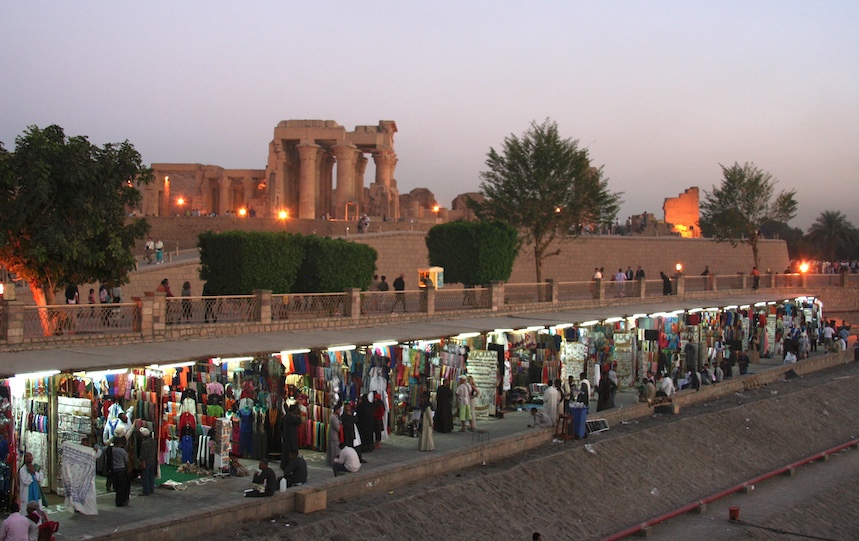
An attractive stop for Nile River cruises between Egypt’s Luxor and Aswan is Kom Ombo Temple, which is two temples (one dedicated to Sobus the crocodile god, the other to Horus the falcon god) built during the Ptolemaic dynasty. Vendors sell their wares from booths close to the dock. Photo by Mary Bergin
“With fewer guests you really get the chance to meet and know your fellow passengers,” she says. “You get to see and visit many small villages that most tour companies never visit. Life onboard is very casual, no need to pack that formal dress or a suit and tie.”
To Choose a Cruise
From there, the decision about which cruise line to book depends on personal preferences. Is four-star dining important? Regional culinary specialties? Multiple courses vs. a quick buffet? Free wine and beer with lunch?
Maybe it is sufficient for the cruise director to talk about local culture and customs, or maybe you’d gladly pay more to hear from accomplished scholars. Maybe you want exceptional musicians to perform after dinner – or maybe singalongs, trivia contests and talent nights are enough.
“What I have found is it’s very important to talk with my clients, to find out just what they are looking for in their vacation,” McDaniel says. That means addressing presumptions too. A room with a patio door isn’t the same as a veranda with deck chairs. A dock can be steps – or miles – from a port’s biggest sites.
“Bottom line – if you are planning a river cruise, ask yourself what you would like for your vacation,” McDonald advises. “There is a river cruise out there to fit just about everyone’s needs.”
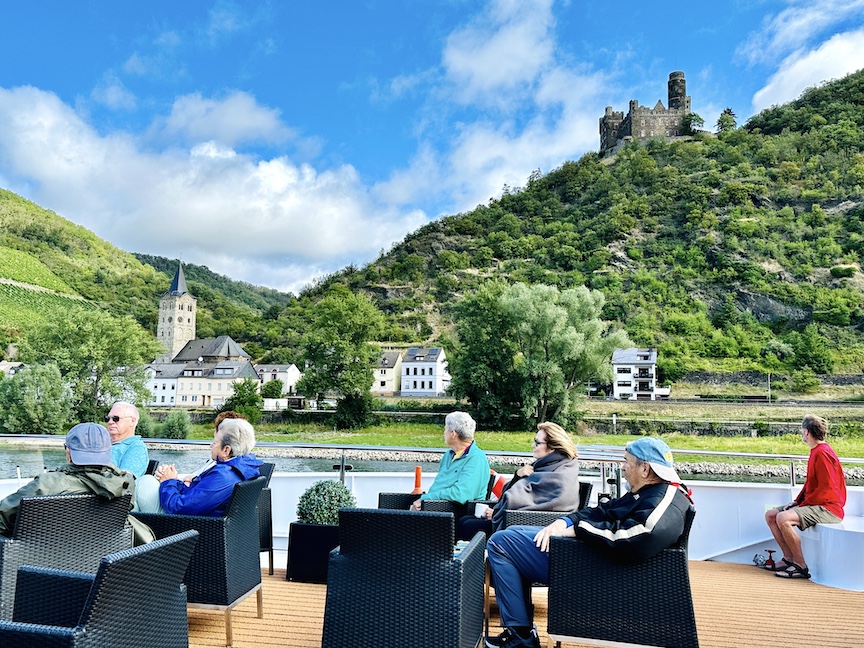
A 40-mile stretch of Middle Rhine Valley in Germany is a UNESCO World Heritage Site, and it has an abundance of castles, easy to spot from the deck when cruising the Rhine River. Photo by Mary Bergin
Up close and personal
Living the dream, for me, was about eagerly counting castles, 28 between Rüdesheim and Koblenz, while sipping Jägermeister on ice (“German medicine,” we were told, with a wink) along a most scenic stretch of the Rhine.
Another cruiser, on vacation from her livelihood as a tour guide, shrugged at what she and colleagues call the ABCs – “another bloody castle.” Depending on the destination, it might mean “another bloody cathedral.”
She said it with a smile, knowing she had plenty of other ways to define the good life while afloat, despite our compact space. For those of us who don’t see many castles or cathedrals in everyday life, those landscapes were a thrill.
The European river cruise can feel like a laid-back float from one country to another. As Ben Bouldin of Cruise Lines International Association told the United Kingdom’s Travel Weekly: “River cruise lines have a rich opportunity in terms of destinations and it’s fantastic to see the boundaries continue to broaden as the sector looks to take people further afield than it ever has before.”![]()
Freelance writer Mary Bergin of Madison, Wis. has spent additional nights afloat on the Nile and New Zealand’s Doubtful Sound. She takes a deep interest in exceptional destinations with a population of less than 5,000, and her most recent book is “Small-Town Wisconsin,” published by Globe Pequot Press.

